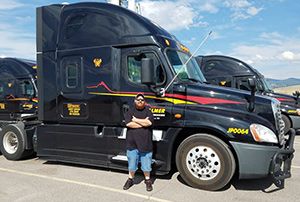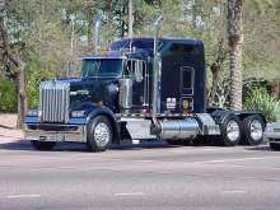10 Speed Downshifting
Topic 15373 | Page 1
Have you used the High Road Training Program?
CDL:
Commercial Driver's License (CDL)
A CDL is required to drive any of the following vehicles:
- Any combination of vehicles with a gross combined weight rating (GCWR) of 26,001 or more pounds, providing the gross vehicle weight rating (GVWR) of the vehicle being towed is in excess of 10,000 pounds.
- Any single vehicle with a GVWR of 26,001 or more pounds, or any such vehicle towing another not in excess of 10,000 pounds.
- Any vehicle, regardless of size, designed to transport 16 or more persons, including the driver.
- Any vehicle required by federal regulations to be placarded while transporting hazardous materials.
Skip shifting is perfectly acceptable. Just don't do it on your CDL test!
For the record, we were always taught to take turns in 6th but it may depend on the truck.
As far as using your jakes on ice, I can't answer that. But I do use my jakes in the rain and I've heard you aren't supposed to do that either.
If you slam on the brakes due to a traffic emergency without downshifting, you run the risk of stalling due to the truck not being in the correct gear for your speed. Once you get some practice you will be able to downshift in a hurry with no problems.
CDL:
Commercial Driver's License (CDL)
A CDL is required to drive any of the following vehicles:
- Any combination of vehicles with a gross combined weight rating (GCWR) of 26,001 or more pounds, providing the gross vehicle weight rating (GVWR) of the vehicle being towed is in excess of 10,000 pounds.
- Any single vehicle with a GVWR of 26,001 or more pounds, or any such vehicle towing another not in excess of 10,000 pounds.
- Any vehicle, regardless of size, designed to transport 16 or more persons, including the driver.
- Any vehicle required by federal regulations to be placarded while transporting hazardous materials.
Carlos, you know to take any turn slow. Slowing down sooner is way better than having to squeeze the brakes hard in the middle of a turn. You know the turn is coming so start with downshifting as needed, and use the brakes for the finishing touch before you get to the corner. I don't worry about gear numbers (but as a newbie that will help you keep good power to the wheels without stalling.), I concentrate on getting through the turn slowly.
As for icy roads, the engine retarder only puts braking power to the drives - the middle set of wheels in the wheel chain. They do not control the steers or the tandems on the trailer so these are still doing their own thing. There is a way to use them in slick conditions, but as a new driver, don't waste you thoughts on that now.
YouTube is one of those double edged swords. You can find good techniques for lots of things, but it's also easy to find stupid ( = dangerous) stuff too*. Again, as a new driver, it may be hard to tell the good from the bad right now.
* Someone makes a video of skiing backwards down a mountain. Are you going to do that?
Tandems:
Tandem Axles
A set of axles spaced close together, legally defined as more than 40 and less than 96 inches apart by the USDOT. Drivers tend to refer to the tandem axles on their trailer as just "tandems". You might hear a driver say, "I'm 400 pounds overweight on my tandems", referring to his trailer tandems, not his tractor tandems. Tractor tandems are generally just referred to as "drives" which is short for "drive axles".
Tandem:
Tandem Axles
A set of axles spaced close together, legally defined as more than 40 and less than 96 inches apart by the USDOT. Drivers tend to refer to the tandem axles on their trailer as just "tandems". You might hear a driver say, "I'm 400 pounds overweight on my tandems", referring to his trailer tandems, not his tractor tandems. Tractor tandems are generally just referred to as "drives" which is short for "drive axles".
HOS:
Hours Of Service
HOS refers to the logbook hours of service regulations.OWI:
Operating While Intoxicated

Yeah not sure if it's correct but in emergency situation I was told to push the clutch in and brake. So you don't risk stalling out. Other than that yeah, 5th gear is usually what my instructor wanted sometimes fourth. But I always failed to downshift to that xD still working on it. I get my trainer in a couple days so I'll get my practice in on downshifting I'm sure the 3 weeks I'm out.

Myy instructor tells us to only use the svc brakes to brake, then when coming to the complete stop clutch it to avoid stalling. If you clutch first or at the same time you throw the tranny into neutral = bad situation. I would THINK It's the same idea when emergency. Im sure the right somewhere in the book so don't take my word for it...
Yeah not sure if it's correct but in emergency situation I was told to push the clutch in and brake. So you don't risk stalling out. Other than that yeah, 5th gear is usually what my instructor wanted sometimes fourth. But I always failed to downshift to that xD still working on it. I get my trainer in a couple days so I'll get my practice in on downshifting I'm sure the 3 weeks I'm out.
New Reply:
New! Check out our help videos for a better understanding of our forum features

















Preview:








 TT On Facebook
TT On Facebook
First, a bit of where Im at on the learning curve:
2/4 weeks. 1st week class, 2nd week logbook and observing, last 3 days been out shifting/driving on streets/hwy with instructor. I have the upshifting down for the most part (rough for now). I have the downshifting somewhat down, too, but usually forget what gear I'm on and 'sometimes' whilst on traffic I try to downshift as if I was upshifting (without reving up) due to traffic pressure and trying to process everything my instructor is throwing at me at the same time lol. Haven't backed up or paralleled yet, and getting the hang of making turns.
My questions:
When approaching a right turn with no light or stop sign, my instructor asks me to start downshifting early, which makes sense, progressively from 10 to 5 and then turn. So, is that how it's SUPPOSED to be done? Seems kind of excessive and time consuming. Is it right to skip gears and maybe only shift twice? If so, would this still apply if loaded heavy? How about when approaching a stop sign?
Also, is it right to fully brake with the service brakes w/out downshifting if a traffic situation arises (non-emergency) that doesn't allow a rookie enough time to shift maybe twice?
Bonus: On the book, it says not to use the jakes when icy, especially on a downgrade. If all goes well, it is possible that I'll be getting my experience this winter. So I searched and people on youtube are using jakes on an icy downgrade... Im confused. I know I should ask all these to my instructor but I'll have to wait until monday... lol. Appreciate any input!
I know, got a lot to learn...
Logbook:
A written or electronic record of a driver's duty status which must be maintained at all times. The driver records the amount of time spent driving, on-duty not driving, in the sleeper berth, or off duty. The enforcement of the Hours Of Service Rules (HOS) are based upon the entries put in a driver's logbook.
TWIC:
Transportation Worker Identification Credential
Truck drivers who regularly pick up from or deliver to the shipping ports will often be required to carry a TWIC card.
Your TWIC is a tamper-resistant biometric card which acts as both your identification in secure areas, as well as an indicator of you having passed the necessary security clearance. TWIC cards are valid for five years. The issuance of TWIC cards is overseen by the Transportation Security Administration and the Department of Homeland Security.
OWI:
Operating While Intoxicated